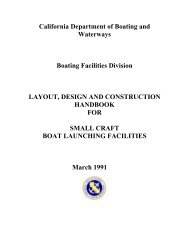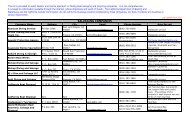EVEREST June, 2013 - California Department of Boating and ...
EVEREST June, 2013 - California Department of Boating and ...
EVEREST June, 2013 - California Department of Boating and ...
Create successful ePaper yourself
Turn your PDF publications into a flip-book with our unique Google optimized e-Paper software.
Orange County Coastal Regional Sediment Management Plan<br />
<strong>California</strong> Grunion<br />
Grunion is a pelagic, schooling fish that generally occurs from<br />
just beyond the surf line to a depth <strong>of</strong> approximately 60 feet <strong>of</strong>f<br />
s<strong>and</strong>y beaches. The grunion spawns on beaches primarily<br />
between March <strong>and</strong> August, although timing may be earlier or<br />
later depending on environmental conditions <strong>and</strong> location<br />
(Martin 2006). Grunion may spawn on any or all <strong>of</strong> the 4 to 5<br />
nights following full <strong>and</strong> new moons (e.g., spring tides),<br />
beginning a little after high tide (Gregory 2001, Martin 2006). Photo credit: Doug Martin<br />
The CDFG makes available each year the predicted grunion<br />
runs from March through August. Habitat suitability for spawning may vary seasonally<br />
associated with natural s<strong>and</strong> erosion <strong>and</strong> accretion cycles.<br />
<strong>California</strong> Least Tern<br />
<strong>California</strong> least tern is a state <strong>and</strong> federal listed endangered<br />
species. Least terns are migratory <strong>and</strong> are only present in<br />
<strong>California</strong> during the breeding season <strong>of</strong> April through<br />
September (Atwood, et al. 1994). Least terns feed on small<br />
surface schooling fishes such as topsmelt, northern anchovy,<br />
jacksmelt <strong>and</strong> mosquit<strong>of</strong>ish. They forage within one to two<br />
miles <strong>of</strong> breeding colonies (Collins et. al., 1979), although Photo credit: Kathy Keane<br />
non-breeders may forage at greater distances (Massey <strong>and</strong> Atwood, 1980).<br />
Western Snowy Plover<br />
Snowy plover is a federal threatened species <strong>and</strong> <strong>California</strong><br />
Species <strong>of</strong> Special Concern. Critical Habitat has been<br />
designated at several beaches in Orange County. The<br />
USFWS also has identified locations where habitat may be<br />
suitable to support wintering concentrations (wintering areas),<br />
although information on actual use is limited. The breeding Photo credit: Callie Bowdish<br />
season for western snowy plovers extends from early March<br />
to late September. Snowy plovers feed on s<strong>and</strong> crabs, s<strong>and</strong> hoppers, <strong>and</strong> a variety <strong>of</strong> insects<br />
associated with washed-ashore kelp (wrack). Snowy plovers have cryptic coloration <strong>and</strong> shelter<br />
in depressions, which increases their vulnerability to impacts by vehicles <strong>and</strong> human<br />
disturbance (Lafferty, 2000).<br />
Other Species<br />
Other sensitive or high interest biological resources occur or have the potential to occur within<br />
the study area, but are not shown on the figures. These are briefly described below.<br />
Everest International Consultants, Inc. 3.34




